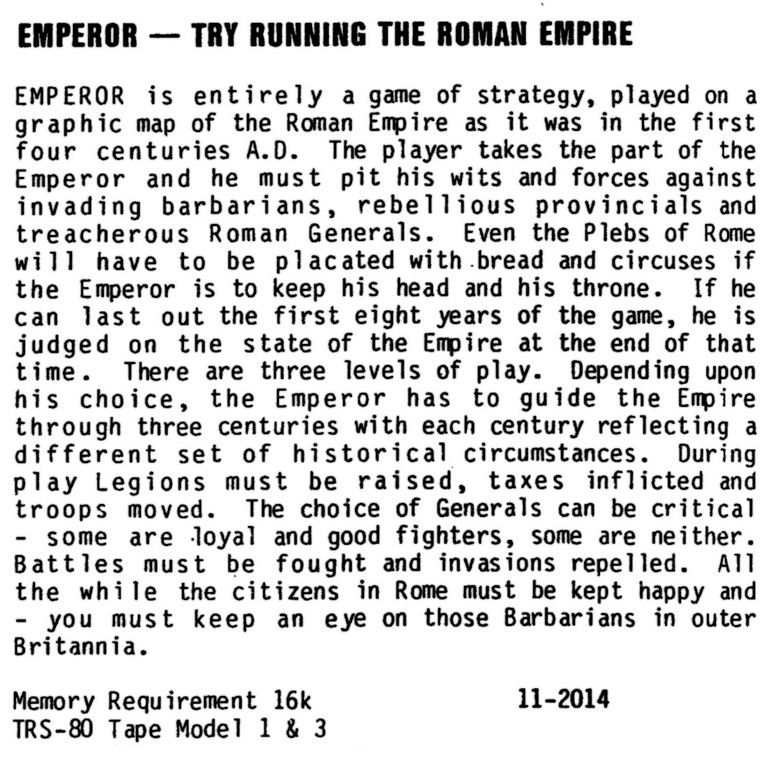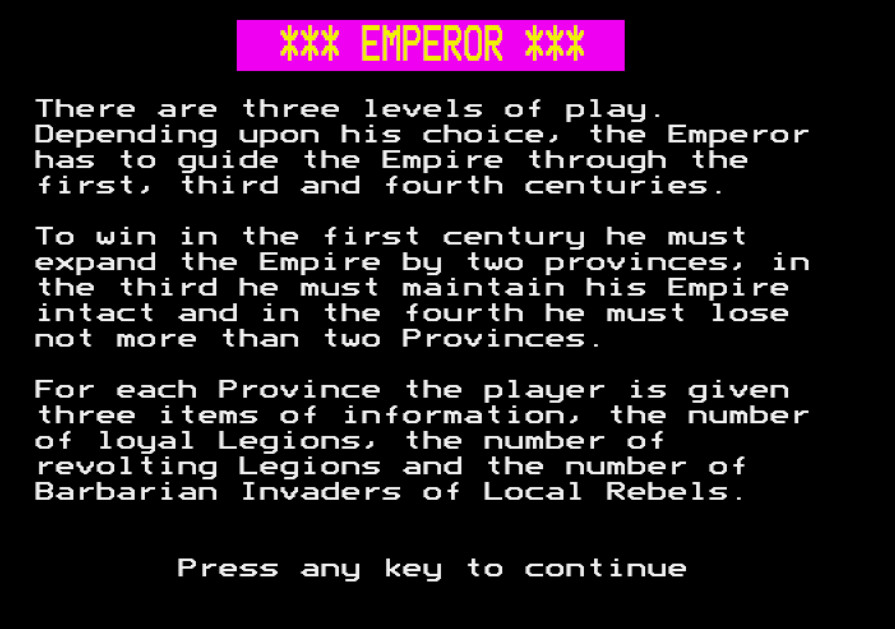Emperor, we have two candidates to lead our legions against the barbarians in Moesia : Manlius Carbo is incompetent and disloyal, while Rutulius Bestia is loyal, and a stellar commander. Whom should we send ?
Is that a trick question ?
Well, if those legions rebel, and I am not saying they will rebel, do you really want Bestia to lead them ?

Your first decision as Emperor is which century you want to be an Emperor in, the 1st century being the easiest, and the 4th the hardest. For this AAR, I am going to pick the 3rd century, because no one has ever heard of the Crisis of the Fourth Century.
After this initial choice, the player is given the military rating of his Emperor from 1 to 5, and I was fortunate to have been anointed by Mars himself :

And with that, I am presented with the general situation of the Empire. My legions are spread all over Europe, and there are rebels (or barbarians, the game uses those terms interchangeably) in several regions : Pannonia, Narbonensis, Armenia, Mesopotamia and Asia.

My objective is to stay in power for 8 years and leave the Empire no worse than I found it. During those 8 years, I must avoid both usurpers trying to proclaim themselves Emperor in Italy and the Senate and People of Rome deciding I am not agreeable to them. Getting killed in a battle is another big no-no.
I start with 2000 denarii. To placate the SPQR, I am offered to buy panem and circenses with part of this money. Having the option is nice, but I prefer to remind everyone that the Senate has no say in politics by buying an extra legion in Italy, fully devoted to my cause. Just to be sure I make a mental note to bring some more from Illyricum. Bread and circuses are fine things, but they won’t stop barbarians or usurpers, will they ?
Now that I’m sure the Senate will not be meddling, It is time to take care of the barbarians. It is clear that I can achieve local superiority everywhere if I move my legions in a rational way, except in Armenia which I fully evacuate for now. It’s safe to deplete regions for a brief period of time : every year includes two moving phases and two battle phases and no new barbarian / rebel is spawned between those phases. Moreover, the Senate only takes a decision about my fate at the end of every year – and that decision is always “you are a fine person and we like you” if there are 5 legions in Italy.
The map at the end of the first movement phase looks like this :

My legions without commanders are not going to make much of an impact. In addition to myself, I will have for the entirety of the game 5 randomly generated commanders. In my case those are :
- Manlius Carbo : Loyalty 2, Ability 3
- Mamilius Laenas: Loyalty 4, Ability 4
- Rutilius Bestia : Loyalty 5, Ability 4
- Clodius Aquilius : Loyalty 3, Ability 5
- Julius Caprarius : Loyalty 4, Ability 4
Overall, a good roster. The mediocre and disloyal Manlius Carbo is sent to Asia where the stakes are low. The slightly more loyal but way more dangerous Clodius Aquilius is sent to Africa – you never know the Sea People may come back from the long-lost Atlantide. Finally, the 3 competent and loyal commanders are sent to Pannonia, Narbonensis and Mesopotamia to crush the rebels. I don’t like to command armies myself if I am not forced to – no one wants to see a promising career ending early due to a pilum accident.
The results are worthy of Rome, except in Asia where Manlius Carbo is humiliated by a bunch of barbarians who keep him at bay :

In Emperor, battles are all-or-nothing : either all barbarians are destroyed, or all Romans are, or no one is. This means Europe is cleared from all barbarian activity, and I can use the second movement to redistribute my legions, in particular sending a good number in Italy, to show the Senate how safe we all are. As for Asia and Armenia, I redeploy my 2 legions from Asia and my 5 legions from Mesopotamia to Armenia under the command of Rutilius Bestia – the Asian rebels will wait.

Rutilius Bestia delivers, and the Armenians are pacified.
The second year looks like an easier version of the first. There are some minor rebellions in Gallia, Mesopotamia and Syria, but they are all crushed by the end of the year. The same fate is bestowed on the inhabitants of Asia. With less rebellious provinces, I also generate 3 000 denarii that I store.
The third year, Rome has a short opportunity to close the gates of Janus : a minor rebellion in Gallia is crushed effortlessly in my first move, and I have nothing to do on my second move :

But of course, it does not last, and in year 4 I suffer massive barbarian attacks in Moesia and Armenia :

Well, that’s not great, especially since I don’t have enough legions one move away from the rebel activity, though I am confident I can crush them at the end of my second move :

I allocate 8 legions to my most loyal servant Rutilius Bestia in Moesia, while Julius Caprarius handles Armenia. I am still personally in Italia and for the record Clodius Aquilius is still in Africa – no sea people yet.
In Moesia, Rutilius Bestia delivers again, though Julius Caprarius disappoints in Armenia.

Well, who cares about Armenia. It is not like the barbarians will march on Rom…

Wait … what ?

One can only be betrayed by those one trusts. Rutilius Bestia now controls 8 legions and can be in Rome by the end of next year – usurpers move twice a year.
In addition to the usurper in Moesia, I have some minor rebellions in Gallia and Britania, and the rebels in Syria have increased their power.
I immediately grab as much cash as I possibly can. I double-tax every single region I control (except Aegyptus – its grain is too precious to give the locals a pretext to rebel). I buy a lot of bread and put circuses on every plaza in Rome : I will need all my Italian legions to march to the North East, where they are joined by the legion from Narbonensis and the one from Grecia. I also take personal command of that army – this is a battle I must win.
Rutilius Bestia and I meet in Illyricum. This is going to be a battle that enters the annals of Rome :

Sadly, no hi-res graphics for that battle, but a laconic message :

I won. Rutulius Bestia is dead. His legions fall back in line, except one destroyed in the combat. I split this huge army of 16 legions in two : one-half will cross to Asia and reinforce the forces already there, the rest will be distributed in Europe where I expect rebellions, given how much I taxed everyone. A small number returns to Italy.
As expected, the 6th year is difficult : some significant rebellion and barbarian attacks (in particular in Britannia), and so little revenue that I must immediately disband 5 legions (I earn 1000 denarii by disbanded legion).

I am a bit short-handed in terms of commanders I can trust, so I have to personally lead the forces in Africa. Still, I manage to quell all unrest except the barbarians in Britannia – my legions cannot reach it in time. Left to themselves, the Britons gather more forces year 7 :

As I finally gather a force large enough to teach the Britons a lesson, year 8 becomes Pandemonium.

The massive barbarian activity in Britannia is still there, but half of Europe falls to the Barbarians – at least the Eastern part of the Empire is safe.
I personally lead a large force in Britannia, but I do not manage to destroy the Barbarians there. Meanwhile, my commanders pacify Europe. At the beginning of Year 9 (which is not played, as the game lasts 8 years), all has been reconquered except Moesia and Britannia :

I won, but clearly I am no Trajan :

Review and Rating

Emperor by R. Kirby and R. Bodley Scott, published by Molimerx, UK
First release : 1980 on TRS-80,
Tested on : TRS-80 emulator and BBC Micro emulator
Total time tested : 3 hours
Average duration of a campaign: 45 minutes
Complexity: Easy (1/5)
Would recommend to a modern player : No
Would recommend to a designer : No
Final Rating: Flawed and obsolete
Emperor is a 1980 TRS-80 game that would have totally escaped my attention if it had not been ported in 1983 to BBC Micro, where I found it while preparing my list of 1983 games. Emperor is credited to R. Bodley Scott and R. Kirby. Kirby is a total mystery to me, but it was a huge surprise for me to find (Richard) Bodley Scott. Bodley Scott is totally forgotten as the author of 4 TRS-80 games (Emperor in 1980, Hannibal (sadly lost) in 1980 or 1981, King Arthur in 1981 and according to him a last lost one about the Roman-Seleucid War whose name he forget), but the grognards among you should know Bodley Scott’s later creations as he is the co-creator of the Field of Glory wargame ruleset, which is pretty much one of, if not the current standard ruleset for pre-modern miniature battles. Field of Glory was ported on computers by Slitherine in 2009, and then again by Bodley Scott’s own development studio Byzantine Games with Field of Glory II in 2017, a game I warmly recommend. Byzantine Games also released some offshoots: Pike & Shot, Sengoku Jidai and finally in 2021 FOG: Medieval, making Bodley Scott one of the very few developers active in 1980 and still active today.
As for the publisher, Molimerx was a British company founded in 1979 that claimed to be the world’s first distributor of TRS-80 software of all sorts in the early 1980s, but never managed the transition to more modern platforms. Still, it tried, and the 1983 port of Emperor to BBC Micro is a testament to that.

Credited to someone called D.S. Peckett, this version is better looking, has a marginally better UI but is in my opinion worse due to a nasty bug : it is not possible to move legions from Greece to Asia, so the only solution to reinforce Asia from Europe is a long trek through Hispania and Africa. The game also states that each “century” has an objective, but checking the code (in BASIC) I am not sure it has any real impact.

A. Immersion
Impossible to score the game highly there. The game has no real graphics (because 1980, and because TRS-80) and decisions are very high-level and simplified.
Rating : Very poor
B. UI, rules and outcomes
The game is simple enough, but still the UI is frustrating. In particular, a normal game would tell you about your future expense (=legion maintenance), then your “normal revenue”, and then ask you whether you want to double tax some provinces to make up for the difference, if any. But in Emperor, you are asked whether you want to double-tax a province before knowing whether you need it.
Another frustration comes from the commander allocation phase. Every turn, you must either allocate none or all your generals. Since generals don’t follow armies (they are allocated to a region, not to a force), in practice you need to reallocate 5 generals every turn, even that one guy you absolutely don’t want to use because he is neither loyal nor competent.
Finally, the game is more hermetic than it could have been because nothing is explained. For instance, in my initial tests, I was systematically deposed by the Senate after a couple of years at most, despite what I believe was a good military performance. I had to check the code of the game to understand what were the condition for the Senate asking you nicely to step down.

Rating : Very poor
C. Systems
Full disclosure, even though I checked a bit the code of the game there are many features I don’t understand :
- How are taxes and expenses calculated ?
- How are revolt risks calculated ? Does the amount of local legions matter ?
- Most mysterious of all, and not covered in the AAR : there are some “off-map” regions full of barbarians. They are death traps if you don’t send a massive force you can manage to conquer them, but then I have no idea what it does. Does conquering those regions limit the number of barbarian attacks ? Can you tax those regions ? I don’t know.

The one thing I understood from the code is that the Senate overthrows you if [number of legions + thousands of denarii distributed as bread & circus] is below a random number from 0 to 5. Said otherwise it’s not enough to just keep 5 legions in Italy at the end of the year. After all, by the end of the 1st Century Emperors could not trust the Praetorian guard anymore.
I found the core of the game (allocating legions and generals to quell rebellions while avoiding usurpers, then use the “free” provinces to pay for the legions) simple but satisfying. Armies without generals are absolutely terrible, and in any event the game forces you to allocate generals to all armies with more than 3 legions, so it is hard to sideline all generals. In addition, as happened to me, even the most loyal generals can cross a metaphorical Rubicon if you give them a tantalizingly large number of legions. This means you are never absolutely safe from usurpers.
Unfortunately, the only way to beat a large army of legionnaires is with an even larger army of legionnaires, and most of the time you want to lead this larger army yourself, which makes your “personal skill” the most contributing factor to your success.
A final complaint is that all regions are so similar. With the exception of Rome and apparently, if I read the code correctly, Egypt, all the provinces are the same. I would have much prefered to have some provinces bring more soldiers, or more taxes, or more happiness to Rome, or maybe even ship transport capacity, so as a player you would have to make strategic decisions on which regions to defend and which regions to sacrifice. Without this, your only decisions are how to mop up rebels the most efficiently while limiting usurpation risk.
Rating : Poor
D. Scenario design and balancing
There are 3 difficulty levels (matching the 3 centuries), with the hardest difficulty challenging but manageable once you have understood the hidden rules of the game. While the initial deployment of the legions is always the same, the generals are randomized every game. In my experience, your pool of generals and the skill of your emperor determine the difficulty of your game much more than the century. If you don’t have a couple of loyal generals (including yourself) with skill 4 or 5, you are going to have a hard time.

The game quickly feels repetitive, though the first two games after you understand the rules are fun.
Rating : Very poor
E. Did I make interesting decisions ?
Rarely. Most choices felt obvious.
F. Final rating
Flawed and obsolete. Some of those early 1980s wargames offer an experience you cannot find with modern games anymore : simple but original gameplay experience that does not overstays its welcome and is over in some 30-45 minutes. This made me rate pretty high games that are totally forgotten today : V.C. or Starbase Hyperion for instance. Emperor could have scratched that itch but fails due to its UI, its obscure rules, the lack of strategic options and the repetitiveness of it all. Still, I was happy to play it and it made me curious about Bodley-Scott’s other early wargames : maybe these would fullfill their potential !